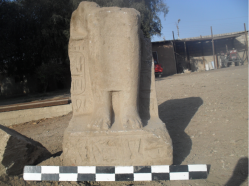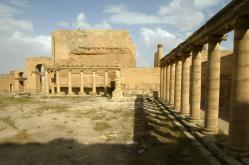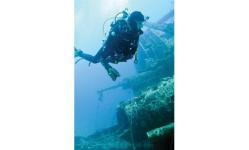INSTITUT SUPERIEUR D'ANTHROPOLOGIE
INSTITUTE OF ANTHROPOLOGY
ONLINE COURSES / COURS A DISTANCE
SPRING TERM : APRIL 2015
REGISTER NOW
IRAQ -Khorsabad - Iraq’s minister of tourism and antiquities says the government is investigating reports that the ancient archeological site of Khorsabad in northern Iraq is being the latest to be attacked by the Islamic State militant group. Khorsabad was constructed as a new capital of Assyria by King Sargon II shortly after he came to the throne in 721 B.C.
http://www.thestar.com/news/world/2015/03/08/ancient-site-khorsabad-attacked-by-islamic-state-reports.html?
EGYPTE –  Akhmim - Part of a statue representing a sitting woman has been discovered by the Egyptian Tourist Police in Akhmim in the Sohag Governorate. The statue, which was confirmed to be original by Minster of Antiquities Mamdouh Al-Damaty, was found during digging to establish a new residential tower in Akhmim Sharq city. General Director of the Sohag Archaeological Area, Gamal Abdel Naser, announced that the statue is 140cm tall and 56cm wide. Moreover, it represents the lower part of a sitting woman. Additionally, at the left side of the statue appear four vertical hieroglyphic lines in bas relief of the titles of the pharaoh, Ramses II. The statue’s cleaning procedures and text studies are currently ongoing. Al-Damaty also said further inspections are being carried out to determine whether the construction site contains other archaeological objects or not.
Akhmim - Part of a statue representing a sitting woman has been discovered by the Egyptian Tourist Police in Akhmim in the Sohag Governorate. The statue, which was confirmed to be original by Minster of Antiquities Mamdouh Al-Damaty, was found during digging to establish a new residential tower in Akhmim Sharq city. General Director of the Sohag Archaeological Area, Gamal Abdel Naser, announced that the statue is 140cm tall and 56cm wide. Moreover, it represents the lower part of a sitting woman. Additionally, at the left side of the statue appear four vertical hieroglyphic lines in bas relief of the titles of the pharaoh, Ramses II. The statue’s cleaning procedures and text studies are currently ongoing. Al-Damaty also said further inspections are being carried out to determine whether the construction site contains other archaeological objects or not.
http://www.dailynewsegypt.com/2015/03/08/pharaonic-statue-discovered-in-sohag/?
IRAQ –  Hatra - Iraqi officials in the northern city of Mosul said Saturday that Islamic State militants have begun demolishing Hatra, a move UNESCO described as “cultural cleansing.” An official with the ministry of tourism and antiquities’ archaeological division in Mosul told The Associated Press that multiple residents living near Hatra heard two large explosions Saturday morning, then reported seeing bulldozers begin demolishing the site. He spoke anonymously for fear of reprisal.Hatra, located 110 kilometers (68 miles) southwest of the city of Mosul, was a large fortified city during the Parthian Empire and capital of the first Arab kingdom. A UNESCO world heritage site, Hatra is said to have withstood invasions by the Romans in A.D. 116 and 198 thanks to its high, thick walls reinforced by towers. The ancient trading center spanned 6 kilometers (4 miles) in circumference and was supported by more than 160 towers. At its heart are a series of temples with a grand temple at the center — a structure supported by columns that once rose to 100 feet.
Hatra - Iraqi officials in the northern city of Mosul said Saturday that Islamic State militants have begun demolishing Hatra, a move UNESCO described as “cultural cleansing.” An official with the ministry of tourism and antiquities’ archaeological division in Mosul told The Associated Press that multiple residents living near Hatra heard two large explosions Saturday morning, then reported seeing bulldozers begin demolishing the site. He spoke anonymously for fear of reprisal.Hatra, located 110 kilometers (68 miles) southwest of the city of Mosul, was a large fortified city during the Parthian Empire and capital of the first Arab kingdom. A UNESCO world heritage site, Hatra is said to have withstood invasions by the Romans in A.D. 116 and 198 thanks to its high, thick walls reinforced by towers. The ancient trading center spanned 6 kilometers (4 miles) in circumference and was supported by more than 160 towers. At its heart are a series of temples with a grand temple at the center — a structure supported by columns that once rose to 100 feet.
http://www.japantimes.co.jp/news/2015/03/08/world/islamic-state-destroying-another-ancient-archaeological-site-iraq/#.VPxb5N-uM8o
GRECE –  Amphipolis - Evangelos Kambouroglou, director of the Palaeoanthropology and Speliology Ephorate, department of archaeological research, told the 28th annual archaeological congress on Macedonian and Thracian archaeology at the University of Thessaloniki that according to current evidence, the Lion, dated to the 4th century BC, could not have been placed on the monument. Kambouroglou said, “the Casta tomb hill is natural, not artificial. It consists of sediments of quartzite sand, clay and sandstone, which give it a limited durability and render it unable to support any weight over 500 tons.” The lion with its base weigh over 1,500 tons, and the conclusion he reached is the same that site archaeologists had already known. He added that the box-shaped grave found in the last chamber was made at a different time from the main monument, and is “a cheap construction” that does not fit in with the surrounding monument, but did not date it as bone analysis is pending. Kambouroglou, who has worked closely with chief site archaeologist Katerina Peristeri, said that when he had entered the burial chamber, “there were many human interventions and burnt remains (samples of which have been sent to a Massachusetts institute for analysis), while its roof showed the earth had shifted,” possibly from the same earthquake as that of 597 AD, which is thought to have been so strong it changed the direction of the of Strymon River flow.
Amphipolis - Evangelos Kambouroglou, director of the Palaeoanthropology and Speliology Ephorate, department of archaeological research, told the 28th annual archaeological congress on Macedonian and Thracian archaeology at the University of Thessaloniki that according to current evidence, the Lion, dated to the 4th century BC, could not have been placed on the monument. Kambouroglou said, “the Casta tomb hill is natural, not artificial. It consists of sediments of quartzite sand, clay and sandstone, which give it a limited durability and render it unable to support any weight over 500 tons.” The lion with its base weigh over 1,500 tons, and the conclusion he reached is the same that site archaeologists had already known. He added that the box-shaped grave found in the last chamber was made at a different time from the main monument, and is “a cheap construction” that does not fit in with the surrounding monument, but did not date it as bone analysis is pending. Kambouroglou, who has worked closely with chief site archaeologist Katerina Peristeri, said that when he had entered the burial chamber, “there were many human interventions and burnt remains (samples of which have been sent to a Massachusetts institute for analysis), while its roof showed the earth had shifted,” possibly from the same earthquake as that of 597 AD, which is thought to have been so strong it changed the direction of the of Strymon River flow.
http://greece.greekreporter.com/2015/03/07/amphipolis-lion-not-part-of-casta-hill-researcher-tells-congress/
INDE – Vellalore - An archaeological team from Tirupur unearthed a 2,100-year-old Roman silver coin and 1,700-year-old copper coins in Vellalore in Coimbatore, which was once part of an ancient trade route, a few days ago. The silver coin, weighing a little over 1g, has the sun god Jupiter driving a four-horse chariot on one side."The other side depicts Apollo, the god of music and poetry, wearing a wreath," said S Ravikumar, epigraphist, Virarajendran Archaeological and Historical Research Centre, Tirupur. He said the research team would hand over the coins to the archaeology department soon. He added that four copper coins were issued by the Salvs Republic from 383AD to 408AD. Each copper coin weighs 0.92g. Another copper coin was issued by King Theodosius II between 402AD and 457AD. It's weighing 1.020 gram.Ravikumar said that Palakkad pass was an important stop on ancient trade routes. "We have found artefacts left by Roman traders who arrived at the ancient port of Muziris (now Pattanam) and entered the Palakkad pass. They travelled to the eastern part of TN," said Ravikumar. Vellalore had trading contacts with the Romans from the 2{+n}{+d} century BC to the 6{+t}{+h} century AD. The Tamil Nadu merchant guild knew not only Tamil but also Greek, Arabic, Roman, Hebrew, Aramaic and Chinese, said Ravikumar.
http://timesofindia.indiatimes.com/city/coimbatore/Roman-artefacts-found-in-Vellalore/articleshow/46481451.cms
ARABIE SAOUDITE –  Jeddah - Saudi and German archaeologists have discovered two ancient shipwrecks along the Jeddah coast, in a joint project between the Saudi Commission for Tourism and Antiquities (SCTA) and the Philipps University of Marburg in Germany.The Roman ship discovered is the oldest archaeologically documented shipwreck found along the Saudi Arabian coast, she said. The other ship dates to the early Islamic era. There was also an ancient jetty found, she said. The team had made dives near Jeddah, Rabigh in the north and Al-Shoaibah in the south, along 200 km of coastline. Reinfeld said that citizens in Jeddah had provided the dive team with many leads on other archaeological sites.
Jeddah - Saudi and German archaeologists have discovered two ancient shipwrecks along the Jeddah coast, in a joint project between the Saudi Commission for Tourism and Antiquities (SCTA) and the Philipps University of Marburg in Germany.The Roman ship discovered is the oldest archaeologically documented shipwreck found along the Saudi Arabian coast, she said. The other ship dates to the early Islamic era. There was also an ancient jetty found, she said. The team had made dives near Jeddah, Rabigh in the north and Al-Shoaibah in the south, along 200 km of coastline. Reinfeld said that citizens in Jeddah had provided the dive team with many leads on other archaeological sites.
http://www.arabnews.com/saudi-arabia/news/714831
ITALIE –  Florence - Carbon-14 results on the remains of three people exhumed from Florence's Sant'Orsola convent will soon reveal whether they include those of a woman thought to have sat for Leonardo da Vinci's Mona Lisa painting, researcher Silvano Vinceti said Thursday. Vinceti, who chairs Italy's National Committee for the valorisation of historic, cultural and environmental heritage, said the tests will be ready in 15 days to a month, at the latest. He also told reporters that the tests will determine whether the bones exhumed in the central Florence convent date back to the estimated time of death of Lisa Gherardini, the woman currently believed to have sat for the famous portrait, which is housed in the Louvre Museum in Paris. Gherardini, wife to merchant Francesco Del Giocondo, died in the convent on July 15, 1542. However, Vinceti added that comparison of DNA from the remains found in the convent to that of Gherardini's children, who are buried in a family tomb in Santissima Annunziata, will not be possible, as previously thought. He said that "extracting DNA from Gherardini's family was impossible". If the carbon-14 test results will confirm "that the three human remains date back to the 16th century" and that one of three is likely to have died during a period coinciding with Gherardini's demise, "then it will be possible to confirm, with a very high probability, that we have found the Gioconda". He added that DNA tests will also enable to establish the colour of eyes, hair and skin of the remains of the people found, perhaps solving a centuries-old mystery of the art world over the identity of the woman with the enigmatic half-smile known as 'La Gioconda'.
Florence - Carbon-14 results on the remains of three people exhumed from Florence's Sant'Orsola convent will soon reveal whether they include those of a woman thought to have sat for Leonardo da Vinci's Mona Lisa painting, researcher Silvano Vinceti said Thursday. Vinceti, who chairs Italy's National Committee for the valorisation of historic, cultural and environmental heritage, said the tests will be ready in 15 days to a month, at the latest. He also told reporters that the tests will determine whether the bones exhumed in the central Florence convent date back to the estimated time of death of Lisa Gherardini, the woman currently believed to have sat for the famous portrait, which is housed in the Louvre Museum in Paris. Gherardini, wife to merchant Francesco Del Giocondo, died in the convent on July 15, 1542. However, Vinceti added that comparison of DNA from the remains found in the convent to that of Gherardini's children, who are buried in a family tomb in Santissima Annunziata, will not be possible, as previously thought. He said that "extracting DNA from Gherardini's family was impossible". If the carbon-14 test results will confirm "that the three human remains date back to the 16th century" and that one of three is likely to have died during a period coinciding with Gherardini's demise, "then it will be possible to confirm, with a very high probability, that we have found the Gioconda". He added that DNA tests will also enable to establish the colour of eyes, hair and skin of the remains of the people found, perhaps solving a centuries-old mystery of the art world over the identity of the woman with the enigmatic half-smile known as 'La Gioconda'.
http://www.lagazzettadelmezzogiorno.it/english/carbon-14-results-soon-to-shed-light-on-mona-lisa-s-identity-no798471/